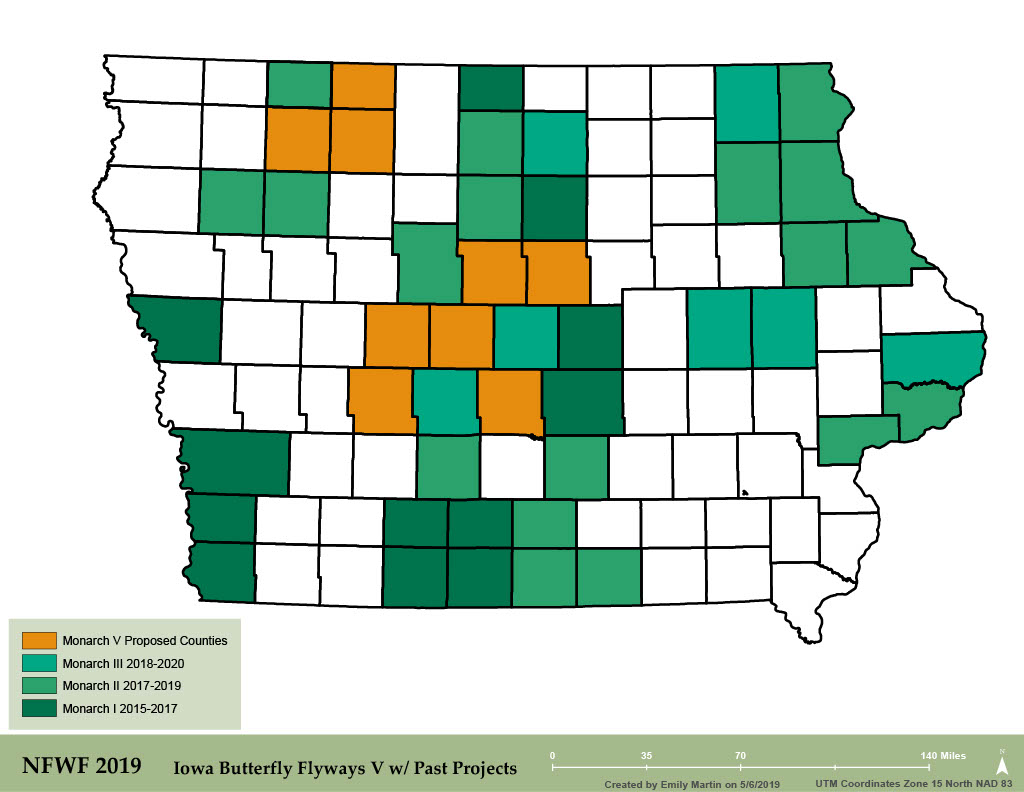Pollinating Partnership
By Daria Mather, communications intern on July 30, 2020 in Blog

Over the last few decades, the iconic Monarch butterfly population has been in peril. Their decline is due largely to loss of habitat, most notably milkweed species from field edges, roadsides, meadows and other sites required for their breeding. The loss of fall flowering nectar plants have also diminished their resilience during their long journey back to Mexico.
As part of a national public/private partnership to address the declining Monarch population and avert its listing as an endangered species, the National Fish and Wildlife Foundation (NFWF) established the Monarch Butterfly and Pollinators Conservation program and fund to help “protect, conserve and increase habitat for the Monarch butterfly and other pollinators” across the country.
Iowa Natural Heritage Foundation (INHF) has received four “Monarch Grants” since 2015, which have been used to support the expansion and diversification of native prairie habitat on public lands and wildlife areas. INHF’s primary role has been to work with federal, county and state public land managers in Iowa who are restoring recently acquired public lands, many of which were previously protected by INHF.
Together, INHF, the Iowa Department of Natural Resources (DNR), the U.S. Fish and Wildlife Service (USFWS) and the county conservation boards have put these funds into action. In the past five years, these groups have planted 5,224 acres of pollinator habitat and helped to restore over 22,000 acres of habitat on 266 different sites across Iowa.
Iowa’s program initially focused on sites in counties along the I-35 corridor. It has since expanded to include restoration on land in the Loess Hills; in the Wetland Management District, which encompasses 35 counties; and along the I-380 corridor in Linn County. This has helped create complexes of pollinator-friendly habitat across the state, which lies in the heart of the Monarch’s North American breeding range.
The DNR’s Prairie Resource Center, which was created in 2000 to act as a seed bank for prairie restoration projects on public lands across the state, has been a critical partner. The Prairie Resource Center provides over 65 species of native prairie grasses and wildflowers to public land managers across the state. However, harvests vary from year-to-year, with some years offering more diversity in the seed mix than others.
“One of the great things about this grant is it kind of helps fill in the gaps,” said Bill Johnson, a biologist at the Prairie Resource Center. “One year I may have good production of prairie clover and then next year I may not have very good seed production. So with this grant, I can utilize the funds to supplement the seeds that I produce here to help increase diversity in our plantings.”
Projects on public lands play an important part in raising awareness about the many benefits of planting prairie on private lands, too.
“There was an initiative to put a pollinator garden in every state park in Iowa,” Johnson said. “Some of those pollinator gardens were one or two acre sites, but several were pretty large sites, 10 or 20 acres. Our state parks are some of the most heavily used public areas of the state. What better place to show our high quality prairie habitat or Monarch habitat than at our state parks?”
The Monarch Grant has also strengthened partnerships and helped diversify natural lands across Iowa for other wildlife.
“I think it's important to note that we're doing something very special by working together,” Johnson said. “This collaboration is expanding and creating great resilient prairies across the state of Iowa that are important not just to Monarch butterflies but a variety of other wildlife species across the state.”
These partnerships have also proven helpful for each group, and they look to ways to partner beyond the grant funded projects.
The work being accomplished through the Monarch Grant is part of a larger statewide effort that also includes planting prairie habitat on private land. The Prairie Partners Program, a cooperative effort between the DNR, the Iowa Chapter of Pheasants Forever and the Iowa Native Plant Growers Association; the Iowa Monarch Consortium, a coalition of organizations led by Iowa State University; the Monarch Research Project; the U.S. Fish and Wildlife Service Partners for Fish and Wildlife Program (Partners Program) and the DNR’s Private Lands Program are among some of the
organizations INHF is working alongside.
“The overall effort is about encouraging individual Iowans, landowners and local agencies engaged in creating wildlife habitat," said Gregg Pattison, a private lands biologist with the Partners Program.
Together, these public/private partnerships are helping to make up lost ground, project by project, but there is still a long way to go.
This spring, the World Wildlife Fund Mexico reported the eastern Monarch butterfly population had declined by 53% compared to last year, well below the extinction threshold. The Monarch’s population is calculated by acres occupied, and scientists estimate that approximately 15 acres is the extinction threshold for the Monarch’s survival in North America. The latest annual count found overwintering Monarchs occupying just 7 acres. Scientists attribute the latest plunge to poor weather
conditions during the spring and fall migrations. The recent drop only underscores the need to provide habitat for the Monarchs that remain.
“No one group can do it alone,” said Senior Director for Conservation Programs Lisa Hein, who leads INHF’s work on the Monarch Grant. “It’s a collective effort.”